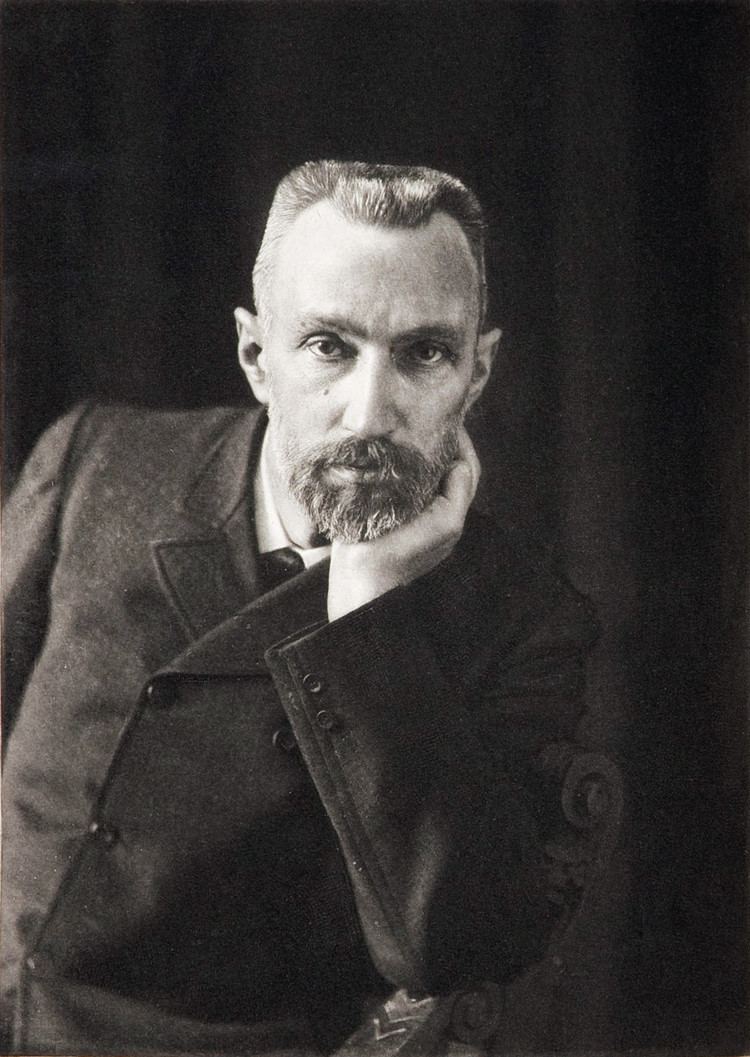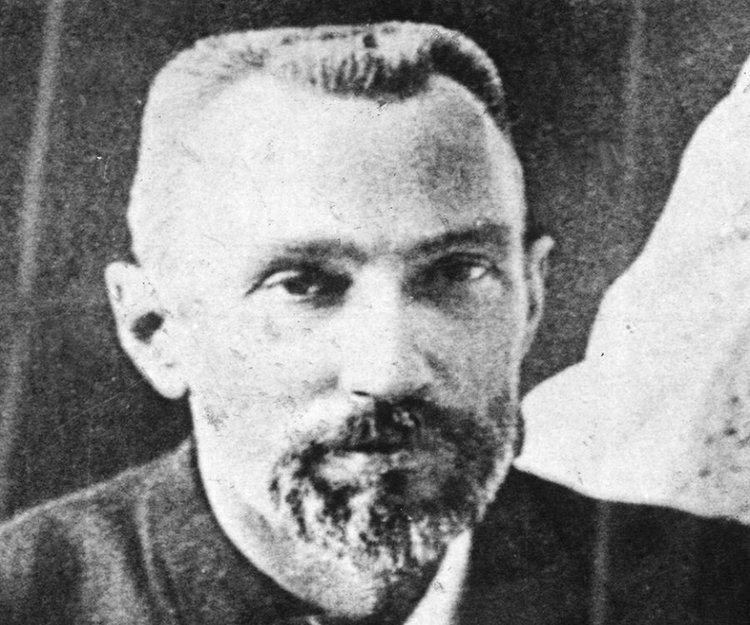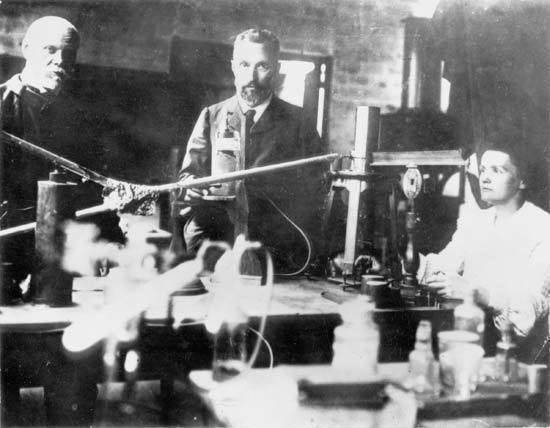Nationality French Name Pierre Curie Fields Physics Role Physicist | Discovered Radium, Polonium Siblings Jacques Curie | |
 | ||
Born 15 May 1859Paris, France ( 1859-05-15 ) Doctoral students Paul LangevinAndre-Louis DebierneMarguerite Catherine Perey Known for RadioactivityCurie's law Died April 19, 1906, Paris, France Children Irene Joliot-Curie, Eve Curie Similar People Marie Curie, Irene Joliot‑Curie, Antoine Henri Becquerel, Eve Curie, Frederic Joliot‑Curie | ||
Pierre curie
Pierre Curie (; [kyʁi]; 15 May 1859 – 19 April 1906) was a French physicist, a pioneer in crystallography, magnetism, piezoelectricity and radioactivity. In 1903 he received the Nobel Prize in Physics with his wife, Marie Skłodowska-Curie, and Henri Becquerel, "in recognition of the extraordinary services they have rendered by their joint researches on the radiation phenomena discovered by Professor Henri Becquerel".
Contents
- Pierre curie
- Marie Pierre Curie Henri Becquerel The Discovery of Radioactivity and Radioactive Elements
- Early life
- Research
- Spiritualism
- Family
- Death
- Awards
- References

Marie & Pierre Curie, Henri Becquerel. The Discovery of Radioactivity and Radioactive Elements.
Early life

Born in Paris on 15 May 1859, Pierre Curie was the son of Eugène Curie (28 August 1827 – 25 February 1910) and Sophie-Claire Depouilly Curie (15 January 1832 – 27 September 1897). He was educated by his father, a doctor, and in his early teens showed a strong aptitude for mathematics and geometry. When he was 16, he earned his math degree. By the age of 18 he had completed the equivalent of a higher degree, but did not proceed immediately to a doctorate due to lack of money. Instead he worked as a laboratory instructor. When Pierre Curie was preparing his bachelor of science degree, he worked in the laboratory of Jean-Gustave Bourbouze in the Faculty of Science.

In 1880, Pierre and his older brother Jacques (1856–1941) demonstrated that an electric potential was generated when crystals were compressed, i.e. piezoelectricity. To provide accurate measurements needed for their work, Pierre created a highly sensitive instrument called the Curie scale. He used weights, microscopic meter readers, and pneumatic dampeners to create the scale. Also, to aid their work, they invented the piezoelectric quartz electrometer. Shortly afterwards, in 1881, they demonstrated the reverse effect: that crystals could be made to deform when subject to an electric field. Almost all digital electronic circuits now rely on this in the form of crystal oscillators.

Pierre Curie was introduced to Maria Skłodowska by their friend, physicist Józef Wierusz-Kowalski. Pierre took Maria into his laboratory as his student. His admiration for her grew when he realized that she would not inhibit his research. He began to regard her as his muse. She refused his initial proposal, but finally agreed to marry him on 26 July 1895.

It would be a beautiful thing, a thing I dare not hope, if we could spend our life near each other, hypnotized by our dreams: your patriotic dream, our humanitarian dream, and our scientific dream. [Pierre Curie to Maria Skłodowska]
Research
Prior to his famous doctoral studies on magnetism, he designed and perfected an extremely sensitive torsion balance for measuring magnetic coefficients. Variations on this equipment were commonly used by future workers in that area. Pierre Curie studied ferromagnetism, paramagnetism, and diamagnetism for his doctoral thesis, and discovered the effect of temperature on paramagnetism which is now known as Curie's law. The material constant in Curie's law is known as the Curie constant. He also discovered that ferromagnetic substances exhibited a critical temperature transition, above which the substances lost their ferromagnetic behavior. This is now known as the Curie temperature. The Curie temperature is used to study plate tectonics, treat hypothermia, measure caffeine, and to understand extraterrestrial magnetic fields.
Pierre formulated what is now known as the Curie Dissymmetry Principle: a physical effect cannot have a dissymmetry absent from its efficient cause. For example, a random mixture of sand in zero gravity has no dissymmetry (it is isotropic). Introduce a gravitational field, and there is a dissymmetry because of the direction of the field. Then the sand grains can 'self-sort' with the density increasing with depth. But this new arrangement, with the directional arrangement of sand grains, actually reflects the dissymmetry of the gravitational field that causes the separation.
Pierre worked with his wife in isolating polonium and radium. They were the first to use the term "radioactivity", and were pioneers in its study. Their work, including Marie's celebrated doctoral work, made use of a sensitive piezoelectric electrometer constructed by Pierre and his brother Jacques. Pierre Curie's 1898 publication with his wife Mme. Curie and also with M. G. Bémont for their discovery of radium and polonium was honored by a Citation for Chemical Breakthrough Award from the Division of History of Chemistry of the American Chemical Society presented to the ESPCI ParisTech (officially the École supérieure de physique et de chimie industrielles de la Ville de Paris) in 2015.
Pierre and one of his students, Albert Laborde, made the first discovery of nuclear energy, by identifying the continuous emission of heat from radium particles. Curie also investigated the radiation emissions of radioactive substances, and through the use of magnetic fields was able to show that some of the emissions were positively charged, some were negative and some were neutral. These correspond to alpha, beta and gamma radiation.
The curie is a unit of radioactivity (3.7 × 1010 decays per second or 37 gigabecquerels) originally named in honor of Curie by the Radiology Congress in 1910, after his death. Subsequently, there has been some controversy over whether the naming was in honor of Pierre, Marie, or both.
Spiritualism
In the late nineteenth century, Pierre Curie was investigating the mysteries of ordinary magnetism when he became aware of the spiritualist experiments of other European scientists, such as Charles Richet and Camille Flammarion. Pierre Curie initially thought systematic investigation into the paranormal could help with some unanswered questions about magnetism. He wrote to his fiancée Marie: "I must admit that those spiritual phenomena intensely interest me. I think in them are questions that deal with physics." Pierre Curie's notebooks from this period show he read many books on spiritualism. He did not attend séances such as those of Eusapia Palladino in Paris in 1905–6 as a mere spectator, and his goal certainly was not to communicate with spirits. He saw the séances as scientific experiments, tried to monitor different parameters, and took detailed notes of every observation. Despite studying spiritualism, Pierre was an atheist.
Family
Pierre and Marie's daughter Irène and their son-in-law Frédéric Joliot-Curie were also physicists involved in the study of radioactivity, and each received Nobel prizes for their work as well. The Curies' other daughter Ève wrote a noted biography of her mother. She was the only member of the Curie family to not become a physicist. Ève married Henry Richardson Labouisse, Jr., who received a Nobel Peace Prize on behalf of Unicef in 1965. Pierre and Marie's granddaughter Hélène Langevin-Joliot is a professor of nuclear physics at the University of Paris, and their grandson Pierre Joliot, who was named after Pierre Curie, is a noted biochemist.
Death
Pierre Curie died in a street accident in Paris on 19 April 1906. Crossing the busy Rue Dauphine in the rain at the Quai de Conti, he slipped and fell under a heavy horse-drawn cart. He died instantly when one of the wheels ran over his head, fracturing his skull. Statements made by his father and lab assistant imply that Pierre Curie's characteristic absent-minded preoccupation with his thoughts contributed to his death.
Both the Curies experienced radium burns, both accidentally and voluntarily, and were exposed to extensive doses of radiation while conducting their research: even their clothing recorded measurable levels of radioactivity. Had Pierre Curie not been killed as he was, it is likely that he would have eventually died of the effects of radiation, as did his wife, their daughter, Irène, and her husband, Frédéric Joliot.
In April 1995, Pierre and Marie were moved from their original resting place, a family cemetery, and enshrined in the crypt of the Panthéon in Paris. Marie Curie was the first woman to be honored in this way "for her own merits".
